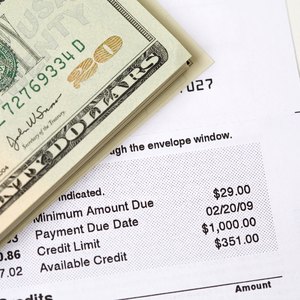
If you make a purchase with your credit card, you'll also receive a receipt showing what you bought. You must keep that receipt in case in you want to return the item, as a credit card statement is not sufficient proof of the cost or type of a particular product. When you use a credit card, you get an online or paper statement that includes a listing of the transactions you made that billing cycle, but not a description of the items you bought. The statement’s description of the transaction might make it obvious what you purchased, but doesn’t always provide details such as the exact product or service.
Tips
While credit card statements reveal the store you made purchases from, they don't list the individual items you bought.
Purchase Details
A credit card statement includes a brief description of each transaction, the date, the name of company with which you did business and the amount charged. Some transaction descriptions may be obvious, while others may require you to think back or even contact the company that billed you. If you purchased an item online or from a small local business, for example, you might not recognize the name of the business when your statement arrives, because the transaction doesn’t tell what you bought. Some companies may use a different name for credit card transactions than they do for their retail operation. If you have any questions about a purchase, it's best to question the charges with the merchant before contacting the credit card company. When you have a dispute, the first question a credit card company representative has usually regards whether you have tried to resolve the issue with the retailer.
Merchandise Returns
If you did return merchandise to a store after purchase and your account was credited, the credit will appear on your statement. Once again, it will only include the amount credited and the vendor, not the specific items you returned.
Other Information
In addition to showing your purchases, a credit card statement lists the total amount you owe based on the type of transaction. For example, your statement might show the total amount you owe for purchases, cash advances and balance transfers. The statement also shows the interest you’ve been charged for those totals and the interest rate for each category. For example, you might pay 10 percent interest on purchases, 20 percent interest on cash advances and 0 percent on recent balance transfers.
References
- Discover: How to Read a Credit Card Statement
- Credit: How To Read Your Credit Card Statement
- MyCreditUnion.gov: Understand Your Credit Card Statement
- MyCreditUnion.gov. "Understand Your Credit Card Statement." Accessed Feb. 15, 2020.
- Federal Trade Commission. "Credit Card Accountability Responsibility and Disclosure Act of 2009," Page 10. Accessed Feb. 15, 2020.
- Discover. "Online Statements and Transactions." Accessed Feb. 15, 2020.
- Consumer Financial Protection Bureau. "Can a Credit Card Company Charge Me Interest After I Close My Account?" Accessed Feb. 15, 2020.
- Consumer Financial Protection Bureau. "What Should I Do If My Payment Does Not Show on My Credit Card Statement?" Accessed Feb. 15, 2020.
- Federal Trade Commission Consumer Information. "Disputing Credit Card Charges." Accessed Feb. 15, 2020.
- Consumer Financial Protection Bureau. "What Can I Do If I Don’t Receive My Credit Card Bill?" Accessed Feb. 15, 2020.
Writer Bio
Sam Ashe-Edmunds has been writing and lecturing for decades. He has worked in the corporate and nonprofit arenas as a C-Suite executive, serving on several nonprofit boards. He is an internationally traveled sport science writer and lecturer. He has been published in print publications such as Entrepreneur, Tennis, SI for Kids, Chicago Tribune, Sacramento Bee, and on websites such Smart-Healthy-Living.net, SmartyCents and Youthletic. Edmunds has a bachelor's degree in journalism.

